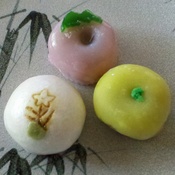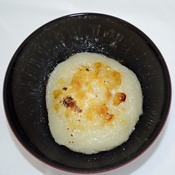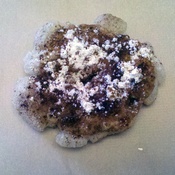Mochi is a quintessential Nikkei food. Mochi is a symbol of our ties to our ancestral homeland, the land of small, terraced rice fields tended by family farmers.
Mochi is made from rice. Not the typical rice you cook at home, but a glutinous rice that is very sticky when cooked. In the traditional method, the rice is steamed, ground and pounded by people wielding wooden mallets into a sticky dough. I have a very vague memory of my extended family coming together to make mochi this way on a very cold winter’s day when I was very young.
Besides the memories, I have a confession to make: I don’t like mochi. No, not the semi-sweet confection that most of you know as mochi and that you can buy at the Benkyodo in San Francisco or at Osaka-Ya in Sacramento. No, not the strawberry, mango, or yuzu flavored mochi with azuki bean paste in the middle. Not the sweetened frozen mochi wrapped around an ice cream center. No not those mochi, but the sticky, gooey, bland, white blob of pounded glutinous rice that my mother served us when we were young.
Typically, she would serve the mochi for breakfast. She would steam the mochi on the stove (this was before microwaves) so that it was hot and gooey. She’d place the mochi in a bowl and put it before us. My brothers would sprinkle their mochi with sugar or shoyu just before gobbling it down. I, on the other hand, would just look at the blob of sticky rice, take a taste, push it aside and have a bowl of Cheerios. My brothers happily grabbed for my bowl for it was more food for them. My mother would give me a discouraged look as though I wasn’t Japanese enough for her.
I don’t know what it was about plain mochi, but I just didn’t like it. Over the years, I had forgotten about those times, about the steaming mochi in a bowl and about my mother’s frown.
Other than my siblings, the rest of my family and my friends don’t know about my aversion to mochi. I’d be embarrassed to tell them. I can imagine their looks of disbelief, “What! You don’t like mochi? What’s the matter with you? Aren’t you Japanese?”
On a recent trip into Sacramento with my daughter, we stopped at Osaka-Ya for one of their famous shaved ices. There I decided to test my childhood aversion to the plain white mochi. We bought a package of frozen plain mochi as well as some of their mochi confections.
When I got home, I took the frozen mochi out of the package and decided to defrost it in the microwave. The mochi quickly defrosted, puffed up and turned into a molten blob that resembled the mochi of my childhood. A quick taste confirmed that.
Now what to do with it? Hot mochi is very sticky. It will stick to anything. I’m thinking that it is better used as an adhesive than a food. Mom used small bits of it to glue envelopes shut. In fact, the Chinese used a glutinous rice in the mortar of the ancient city walls of X’ian. And, it’s so sticky that you have to be careful not to choke while eating it.
I decided to emulate my brothers by sprinkling sugar on top of the mochi. The result was definitely not appetizing to me. I caramelized the sugar with my trusty butane torch. The caramelized sugar did make the mochi more visually appealing, but it still had little taste.
I tried it with shoyu and sugar. A minor improvement, but the mochi was still gummy and bland.
I attempted a mochi fruit pancake next. A bit of flour, fresh strawberries, and tablespoon of jam, mixed well, then flattened and cooked like a pancake. Not one of my better ideas.
How about a mochi donut? I kneaded sugar and cinnamon into the mochi with some flour and formed a donut. Into the hot oil it went. As it was frying, the donut hole closed, so it became a fritter. Once done, I sprinkled it with powdered sugar and more cinnamon. Crunchy on the outside, chewy in the middle. It’s much better this time.
As my daughter and I sampled the fritter, I realized that making plain mochi into something palatable is more work than it is worth. The next time I go to Osaka-Ya, I think I will stick to the fruit flavored mochi with the azuki bean paste in the middle.
© 2012 Ben Arikawa











